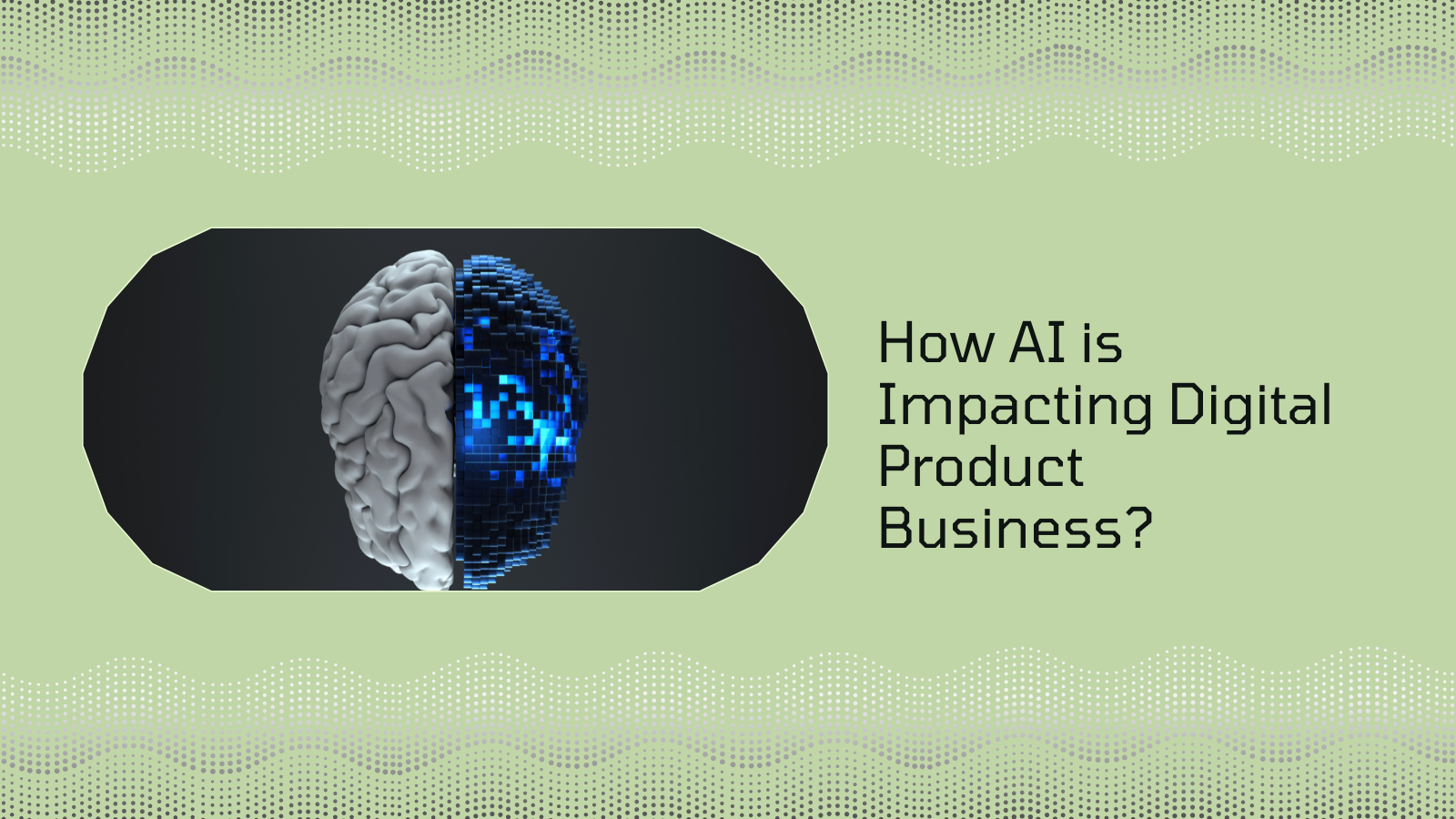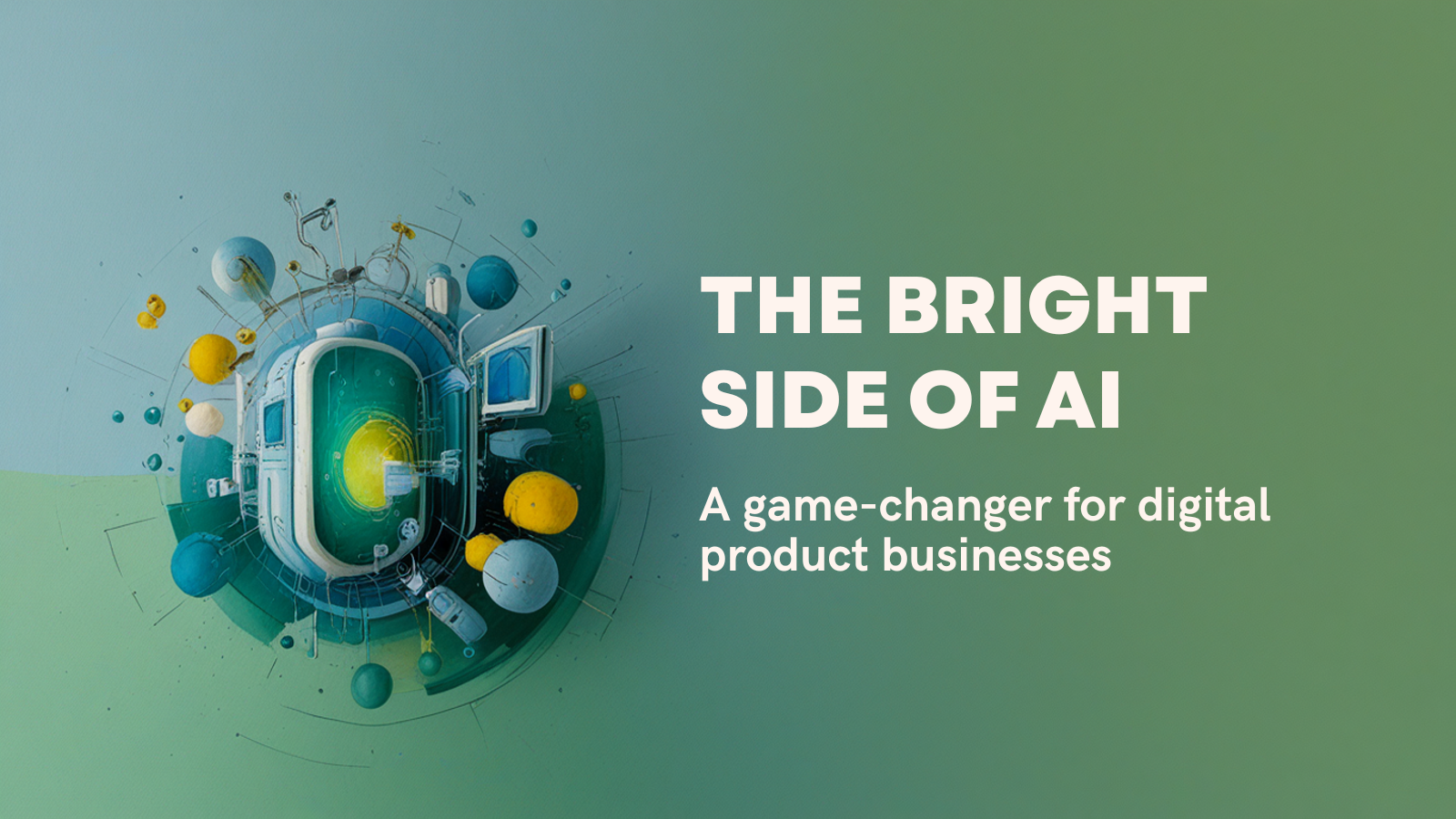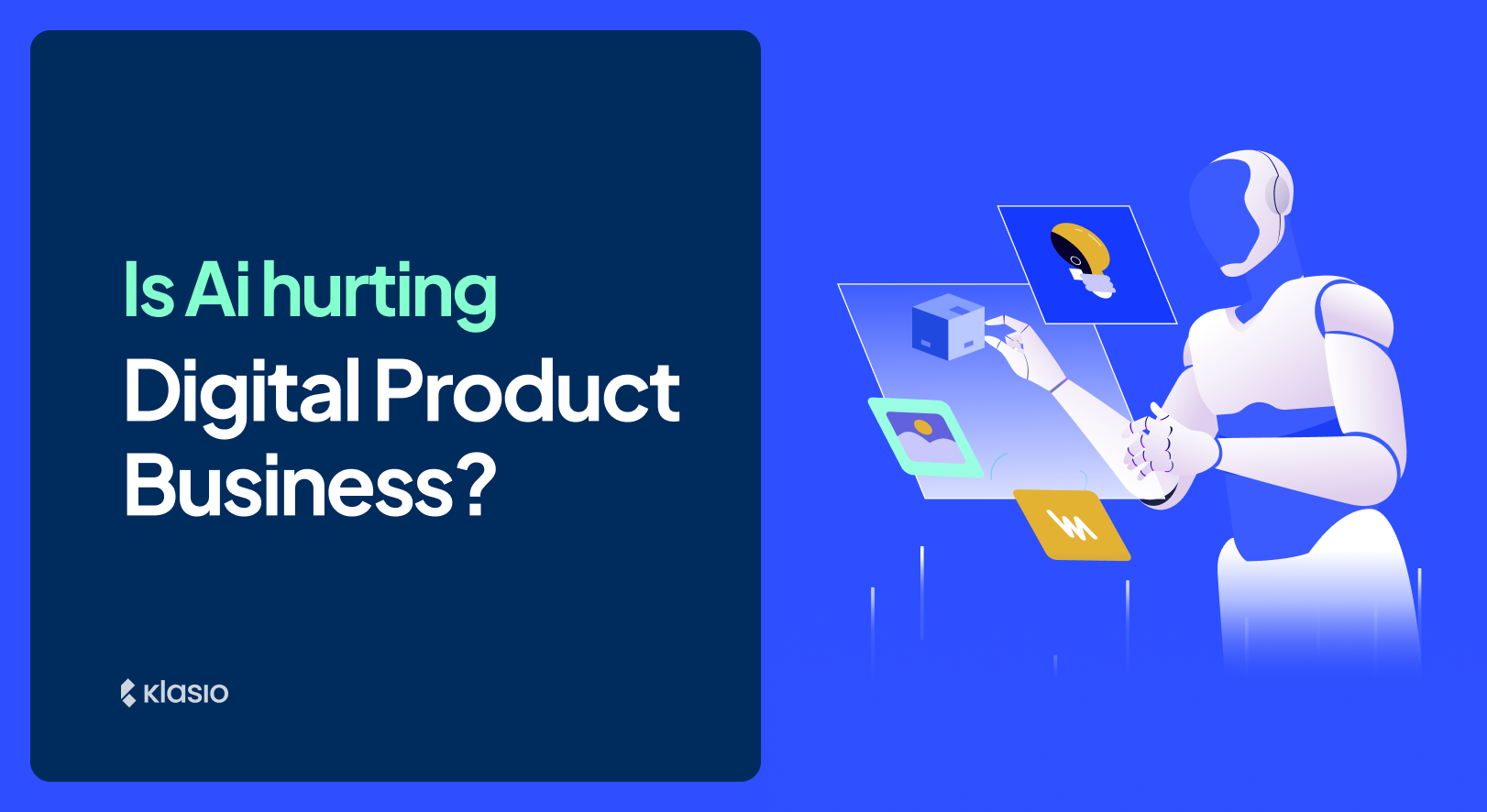Digital product businesses are at a crossroads, with the rise of AI sparking a fierce debate: is this new technology a threat or an opportunity? The concern isn’t unfounded; AI can automate tasks previously done by human creators, from generating copy and images to analyzing market data and creating marketing campaigns. So, there’s a question asked everywhere- “Is AI hurting digital product business?”
However, a deeper look at the data suggests that AI isn’t an existential threat but a powerful tool for growth and innovation. The global AI market is projected to reach over $800 billion by 2030, with AI-driven sales expected to hit $1.3 trillion by 2032.
Furthermore, a significant 51% of companies report that their product performance has improved after implementing AI, and businesses that leverage AI are seeing an average revenue increase of 10-12%.
These stats paint a clear picture: while AI may disrupt some traditional workflows, it’s also a catalyst for unprecedented efficiency, personalization, and revenue growth.
TL;DR
- Yes, AI is hurting digital product businesses and also impacting their growth, depending on your adaptability.
- AI threatens digital businesses by commoditizing products, devaluing creativity, and creating copyright issues. For example, the market can be flooded with AI-generated e-books or logos, making it hard for human-made products to stand out.
- Conversely, AI helps these businesses by boosting efficiency and enabling hyper-personalization. It acts as a co-pilot, automating repetitive tasks like keyword research and social media post creation, freeing creators to focus on strategic work.
- The ultimate impact of AI depends on strategic implementation. The key isn’t to compete with AI, but to use it as a tool to amplify your unique human skills.
- Klasio is a perfect example of this strategic approach. This platform uses AI not to replace a course creator, but to simplify the technical aspects of building a course. Klasio’s AI can instantly generate a course outline and curriculum, allowing the creator to spend more time on crafting the actual content and connecting with their students.
Is AI Hurting Digital Product Business? Let’s Learn Some Facts!

AI’s rapid evolution presents a significant challenge to digital product businesses, particularly by disrupting traditional creative and business models.
Market Saturation and Commoditization
AI-powered tools can generate a huge volume of digital products, like e-books, stock images, and marketing copy, at an unprecedented speed. This capability, while efficient, can lead to market saturation, where an influx of similar, AI-generated products floods the market.
As the supply of these products skyrockets, their value decreases, leading to commoditization. This forces creators to lower their prices to compete, potentially reducing profit margins and making it difficult for original, human-made products to stand out.
Diminished Value of Human Creativity
The ease with which AI can produce art, music, and written content raises concerns about the diminished value of human creativity. When a user can generate a high-quality logo or a blog post with a simple prompt, the effort, skill, and unique perspective of a human creator may be undervalued.
Consumers may become less willing to pay a premium for “handcrafted” digital goods, perceiving them as easily replaceable by AI-generated alternatives. This shift threatens the livelihoods of freelance artists, writers, and designers who rely on their original work to make a living.
Ethical and Copyright Issues
AI’s use of vast datasets for training creates a legal and ethical minefield. Many AI models are trained on existing copyrighted materials without the original creators’ permission or compensation. This has led to lawsuits and concerns about copyright infringement.
Businesses that use AI-generated content face the risk of legal challenges, as the outputs may be considered derivative works.
Furthermore, there are ethical questions about using an artist’s or writer’s style to create new works without their consent. The lack of clear legal frameworks around AI-generated content and its origins poses a significant risk for digital product businesses.
The Bright Side of AI: A Game-Changer for Digital Product Businesses

While some worry about AI, it’s actually becoming a huge asset for anyone in the digital product world. Instead of replacing creators, it’s acting as a powerful partner, helping businesses work smarter, faster, and more effectively.
AI as Your Productivity Co-Pilot
One of the biggest wins with AI is how it handles the boring, repetitive tasks. Think about all the hours spent on keyword research, writing social media posts, or answering simple customer questions.
AI tools can do these jobs in seconds, freeing you up to focus on the big-picture stuff- like developing new product ideas and connecting with your audience. This saves you time and money, allowing you to get more done without needing a bigger team.
The Key to True Personalization
Customers today expect products and recommendations that feel like they were made just for them. AI makes this possible on a huge scale. It can analyze customer data to suggest the perfect product, show them a targeted ad, or even change the layout of your website just for them.
This level of hyper-personalization keeps customers happy and coming back for more, which directly boosts your sales and builds a loyal audience
New Products, New Opportunities
AI isn’t just a tool to improve what you already do; it’s a whole new category of digital products waiting to be created. Entrepreneurs are now building businesses with AI at their core. This includes AI-powered design tools that simplify creativity, personalized learning apps that adapt to each student, and smart chatbots that handle customer service instantly.
By understanding and using AI, you can innovate in ways that weren’t possible before, opening up entirely new markets and business models.
Is AI Hurting or Helping? The Honest Discussion

When we talk about AI and digital products, it’s easy to fall into two camps: the doomsayers who think it will ruin everything and the optimists who see a bright new future. The truth is, AI is a double-edged sword, and its impact depends on how we choose to use it. It’s not a simple case of “good” or “bad.” It’s both.
Besides, Ai is not only the reason your digital products have been underperforming! You must get into deeper research to know the real facts.
On One Hand… The “Bad” Side
AI definitely presents some serious challenges. The biggest one is the risk of market saturation. When AI tools can churn out endless e-books, stock photos, and logos, the market gets flooded. This can devalue the work of human creators and push prices down, making it harder for people to earn a living from their craft. There are also those tricky ethical and legal issues around copyright. Many AI models were trained on existing art and writing, and that creates a murky legal area for businesses.
On the Other Hand… The “Good” Side
But here’s the exciting part: AI is also an incredible partner. Think of it as your new co-pilot. It can handle all the boring, repetitive tasks like writing SEO descriptions, creating social media posts, and answering simple customer questions. This frees you up to focus on the truly creative and strategic work. AI also allows for hyper-personalization on a massive scale, letting you give every customer an experience that feels like it was made just for them. This builds loyalty and boosts sales. And let’s not forget the new products AI can create. Entire businesses are being built around AI-powered tools that solve problems in ways we couldn’t have imagined a few years ago.
The Verdict: It’s All in the Strategy
So, what’s the final answer? AI isn’t inherently good or bad for the digital product business. It’s a powerful tool that, when used poorly, can hurt your business by creating generic, uninspired products.
But when used well to enhance your creativity, streamline your work, and connect with your audience on a deeper level, it can be a game-changer.
For example, platforms like Klasio are a perfect example of this. They use AI not to replace you, but to simplify the tech side of course creation, helping you build an online course without the usual headaches. The future of digital products isn’t about ignoring AI or letting it take over. It’s about using it to make your business smarter, more efficient, and more human than ever before.
Learn how to make a digital product
How to Thrive in an AI-Powered World: Strategies for Digital Product Businesses
This section shifts from analysis to actionable advice. It gives your audience the practical steps they need to adapt and succeed. You can break this down into a few key points:
- Embrace AI as a Partner, Not a Replacement: Emphasize that the goal isn’t to compete with AI but to collaborate with it. Encourage creators to use AI to handle the “grunt work” (like a first draft or SEO optimization) so they can focus on what makes them uniquely human: creativity, empathy, and strategic thinking.
- Focus on the “Human Touch”: Explain that in a world of AI-generated content, the human element becomes even more valuable. Encourage businesses to build their brand around authenticity, personal stories, and direct engagement with their audience. This “human touch” is something AI can’t replicate.
- Develop Unique Skills: Advise your readers to learn how to use AI tools effectively. The person who knows how to write the best prompts or integrate AI into their workflow will have a massive advantage. This includes skills like prompt engineering and data analysis.
- Specialize and Niche Down: Suggest that businesses should find a niche where their specific expertise and human creativity are most valuable. Instead of creating a generic e-book, they could use AI to create a highly specialized one for a very specific audience, adding their unique insights and experience.
- Ethical AI Use: Remind them to be responsible. Acknowledge that using AI ethically and transparently is crucial for building long-term trust with your audience.
This section will provide a powerful and optimistic conclusion, empowering your readers with a clear path forward.
Learn how to generate more sales from digital products
FAQs About AI and Digital Product Businesses
Q: Is AI a direct threat to my job as a digital product creator?
A: Not if you’re smart about it. AI threatens low-effort, generic products. It’s a tool to automate the tedious work, freeing you up to focus on the truly creative, human parts of your business.
Q: Can I get a copyright for a digital product I made with AI?
A: It’s a gray area. Products created entirely by AI generally aren’t eligible for copyright. However, if you use AI as a tool to significantly assist your own creative process, you may be able to claim a copyright.
Q: Will AI-generated content completely flood the market and devalue my products?
A: It’s already happening for simple products. But this also creates a huge opportunity for creators who focus on quality, authenticity, and a unique human voice. Your personal brand becomes even more valuable in a sea of generic content.
Q: How can I use AI ethically in my business?
A: Be transparent and responsible. Tell your audience when you’ve used AI, always check its output for bias or inaccuracies, and respect copyright by not using AI to create works that directly copy other creators.
Final Thoughts: Navigating the Future
The debate over AI and digital products isn’t about good versus bad. It’s about strategy. AI is a powerful tool, a double-edged sword. It can devalue generic work and create market saturation, but it can also be a massive engine for growth and efficiency.
The future belongs to those who use AI to amplify their human creativity, not replace it. By focusing on authenticity, building community, and using AI to streamline tasks, creators can not only survive but thrive. The real power of AI is what it enables us to create when we work together.

Leave a Reply